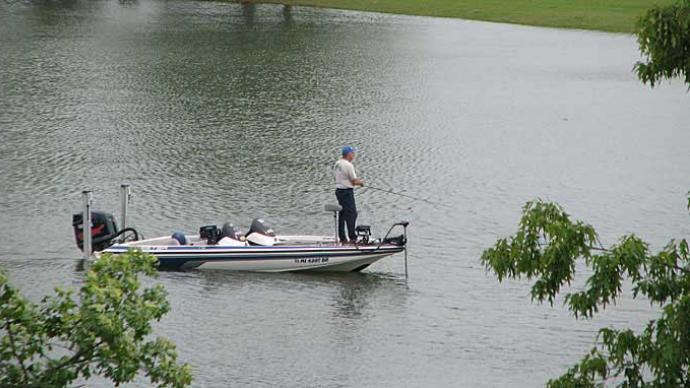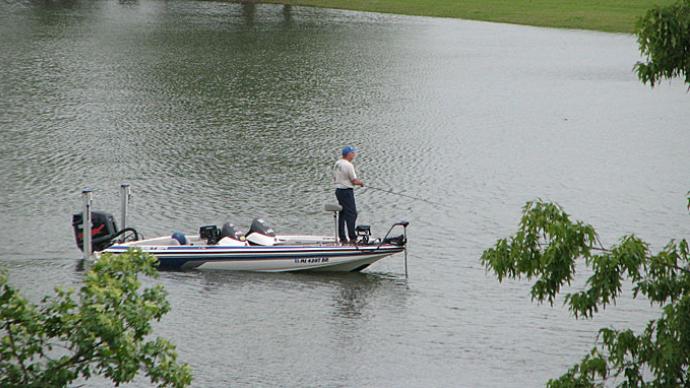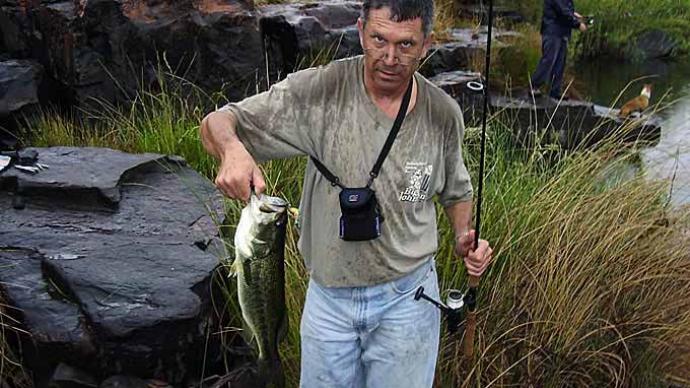
If you're a newcomer to bass fishing, one of the best investments you can make is in a good quality, leak-proof rain suit. Forget the inexpensive "ponchos" on the market - they become worthless in breezy weather. Instead, a good rain suit has a flap-covered, zippered front, Velcro adjusters at wrists and ankles, dry pocket flaps, and waterproof sealed seams all the way around.
Most affordable, high-quality rain suits can be found in mail-order catalogs and larger sporting goods stores. The regular discount department stores also carry a "gotta have" item for fishing in the rain - clear plastic, shoe covers, or "rain boots." Like, who wants pruned feet? And if you buy covers a size larger than your shoes - they'll slip on much easier. It never fails; I'm fishing, and it starts to rain. The fish are biting, and I'm holding a rod and reel in one hand, trying to put on my rain suit with the other. It's hard to keep the rod tip low not to tempt the lightning gods. Now I know how the Indian rain dance started... and it involved a bass boat, a rainy day, and someone who didn't want to lay their rod down.
The number one fishing tip for bass fishing in the rain is darker lures.... any color is fine as long as it's black. Okay - as long as it's dark and preferably opaque- like green pumpkin because bass have a hard time seeing lures in low-light conditions on rainy days. Historically, one of the most productive color combinations on rainy days has been black and blue - with lizards and jigs being top producers on springtime rainy days. And don't overlook black craws with blue pincers.
The lake level is another critical consideration when bass fishing in the rain. Many reservoirs are purposely maintained at low levels throughout the winter months in anticipation of spring floods. As a result, draw-down lakes, as they're called, have long-extended points and bare shorelines. But be prepared for Mother Nature and the quick hand of the dam engineers (that's a dam, as in what holds back the water.) In only hours, a lake can rise from a few inches to several feet, and the fish you had located on the end of the point will have relocated into the shallows.
Where do fish go when the lake level comes up? They come up right along with the water level. Fish out on the ends of points before will move in shallow and take residence under that newly flooded shoreline brush. Fish holding a 15-foot deep ledge may move up to 10- then the 5-foot ledge above it. Remember, when the level changes, you should be changing (depths) too.
To find the lake level, you can drive a stake of wood into the shore near the boat ramp and check it out each day as you launch. Or you might take mental notes while driving down a lake - noting watermarks on bridge pilings or other easily recognizable landmarks. Or do like I did when I first began fishing. I was SO clever. I marked the water level inside my marina boat slip in Missouri. Everyone was abuzz about the rapidly changing lake level scattering the fish. But I disagreed. Every day, as I got in my boat, I checked the mark I'd made on the dock. It never changed, so I just knew the others were wrong. How could so many of them be wrong and only I right?
Then, like a spewing casino slot machine - with sirens wailing and red lights flashing, it occurred to me I had marked the Styrofoam deck instead of the metal post, and it was, of all things, a floating dock! I never made that mistake again! Then, of course, there was the time when this momma alligator and her baby were sunning where I cast and - well, we'll save that one for later. "Later, gator?"
The final rainy weather consideration is water clarity. Bass fishing in the rain gets worse in spring rains, especially if you're fishing a river system where the current flow can pick up momentum and speed for miles above and have a "flushing" effect on the lake. On man-made lakes, the major feeder creeks are usually the first to become muddy. So took for smaller creeks to fish - usually, the lower end of any lake remains clear longer than those up the lake. If the entire lake is muddy, search for the clearest water you can find and the water expected to clear first.
When facing muddy water conditions, forget the quiet, finesse presentations, especially Carolina rigging, which requires relatively good water clarity. Instead, try lures that create noise and vibration so bass can find them easier. Then, douse them with a spray-on scent like garlic, shad, craw, or "Obsession." (I thought I'd throw that in since this is a women's column.) Covering a lot of water in muddy conditions is more productive than slower, more patient techniques.
Good fishing... and remember, what matters most isn't the size or number of fish you catch. It's the memories you make. Don't forget the camera!




